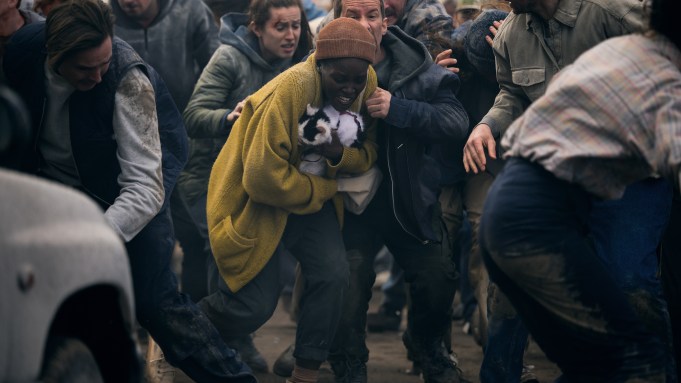
Gareth Gatrell
“A Quiet Place” has become a horror franchise with few equals.
The third installment in Paramount’s post-apocalyptic franchise, “A Quiet Place: Day One,” has surpassed expectations with a $53 million domestic and $98 million worldwide box office debut. It had the best opening of the three films, ahead of the original 2018 “A Quiet Place” ($50 million in its debut) and the 2021 sequel, “A Quiet Place: Part 2” (a $48 million debut, but that took place during COVID). The enduring appeal of the trio of films, with the final installment serving as an origin story, indicates that “A Quiet Place” has enough star power to fill multiplexes on the strength of its name. It joins the company of other big horror properties, such as “The Conjuring,” “Paranormal Activity” and “Insidious,” all of which remain popular but have seen diminishing returns over the course of numerous sequels and spinoffs.
“There have been bigger horror movies,” says David A. Gross, who runs the film consulting firm Franchise Entertainment Research, pointing to adaptations of Stephen King’s “It” (the first opened to $123 million and grossed $704 million; the sequel opened to $91 million and earned $473 million) as well as last October’s “Five Nights at Freddy’s” (the video game adaptation debuted to $80 million and ended its run with $291 million). Still, Gross adds, “no series has been as consistent after three movies as this one. The hook — otherwise stay calm — will carry it indefinitely into the future.
“A Quiet Place Part III” is already in the works and is expected to be a direct sequel to the 2021 installment. Details – including the involvement of franchise creator John Krasinski and stars Emily Blunt, Millicent Simmonds and Noah Jupe – have not been confirmed. But given the sustained interest in the property, Gross isn’t wrong to expect another business winner.
Still, the triumph of “Day One” is remarkable because spinoff stories rarely live up to sequels at the box office. “Furiosa: A Mad Max Saga” missed its target in May, and although last year’s “The Hunger Games: The Ballad of Songbirds and Serpents” was a commercial success, ticket sales didn’t not lived up to the original saga.
Prequels are a harder sell because moviegoers generally know what happens later in the story. They are especially difficult when they don’t have any stars from the original. However, “A Quiet Place: Day One” defied all odds and expanded its audience even though Blunt and Krasinski, who propelled the first two films to box office glory, did not return for this entry. The series maintained the pedigree by starring Oscar winner Lupita Nyong’o alongside “Stranger Things” actor Joseph Quinn in the story set at the start of an alien invasion in New York . “Pig” filmmaker Michael Sarnoski took over for Krasinski, who contributed to the story and served as producer.
Analysts and critics believe that “A Quiet Place: Day One” scored at the box office because it managed to justify its existence and feel like a worthy entry in the franchise. Another favorable factor is the quality of the genre. It’s more sci-fi than slasher, so while it’s scary (of course), the film isn’t scary enough to turn away peripheral fans of the genre.
“It didn’t seem like an attempted scam, but rather a part of the story that needed to be told,” says Paul Dergarabedian, senior analyst at Comscore.
Chris Aronson, Paramount’s president of domestic distribution, said supporters of the property had asked the studio for an origin story about the creepy monsters that eventually forced the population to hide from the terrifying, sound-hunting creatures.
“We listened to the fans to find out what they were looking for,” Aronson says. “Giving them a new city as a setting and new characters helped broaden the audience.”
Dergarabedian believes that these films are especially fun to watch in crowded theaters, because silence is the key to survival. Like its predecessors, “Day One” contains minimal dialogue and lots of tense, thrilling action sequences. This means that inside the room, the slightest gasp, scream, or sip from a cup of soda can echo throughout the room.
“The collective experience makes the show electrifying,” Dergarabedian says. “The audience is afraid to eat popcorn or make noise.”
“A Quiet Place” is one of the highest-rated horror franchises. Movie audiences and critics responded enthusiastically to the latest PG-13 film, which earned a solid B+ CinemaScore and 84% on Rotten Tomatoes. Opening weekend crowds were slightly male (men made up 53% of ticket buyers), while millennials and Gen Z were out in force with 55% of patrons aged 18-34. Many of those viewers chose to watch “Day One” on the biggest screen possible, with nearly 40% of domestic revenue coming from high-end screens like Imax and Dolby.
“The reviews and audience scores are down slightly from ‘A Quiet Place Part II,’ but still excellent for the genre,” Gross says.
There’s a potentially worrying sign as the franchise inevitably expands: budgets continue to rise. The first film, which became a surprise hit grossing $340 million worldwide, only cost $17 million to make. The sequel, another success with $297 million worldwide, sat comfortably in mid-budget territory with its $61 million price tag. “Quietly: Day 1” was slightly more expensive, with a production cost of $67 million. Given its early global ticket sales, the prequel is well prepared for its theatrical release. But Paramount needs these films to remain mid-budget offerings to justify more and more returns to this dystopian universe.
After all, the only thing scarier than ruthless, sound-hunting monsters is shrinking profit margins. At least, if you’re the one paying the bill.